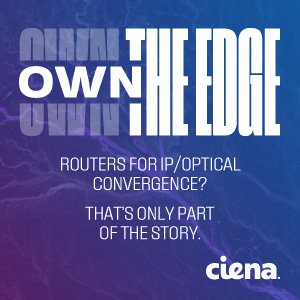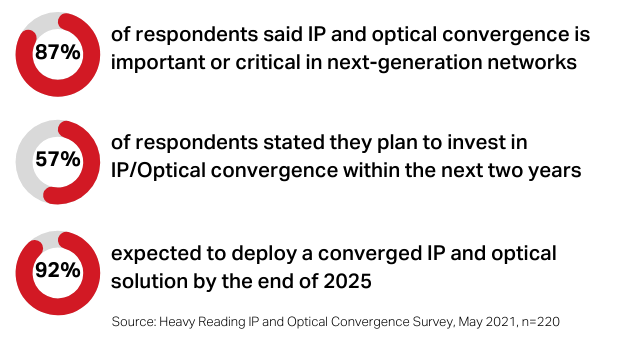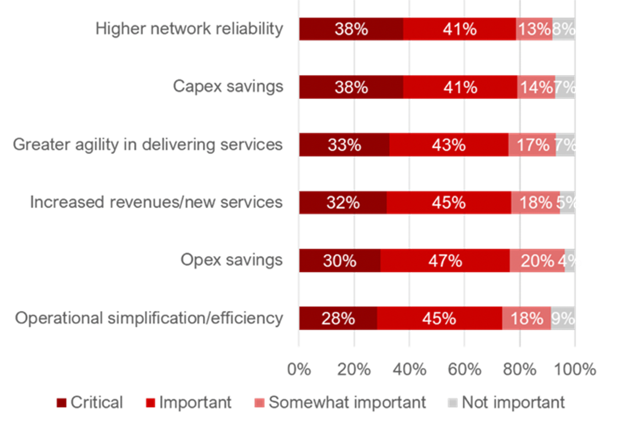Survey says - service providers are ready for the bigger IP/Optical convergence end game
I P routing experts have been kicking around the potential business benefits of IP/Optical convergence for years. A quick look at my own resume and I can point to a project circa 2015 where I ‘successfully positioned IP/Optical convergence in the marketplace.’ So why are we still trying to figure all this out as we head into 2022?
P routing experts have been kicking around the potential business benefits of IP/Optical convergence for years. A quick look at my own resume and I can point to a project circa 2015 where I ‘successfully positioned IP/Optical convergence in the marketplace.’ So why are we still trying to figure all this out as we head into 2022?
Good question. Time and perspective are wonderful things. Back in 2015 the industry was heavy on the aspirational benefits of IP/Optical convergence, but super light on the required technology and the business case to justify this network evolution. For converged networking to really take hold and become a reality, both technology and business motivations needed to catch-up. So, are we there yet?
Let’s look at the technology first, fast forward to today and it is finally starting to catch-up – with advances in routing silicon plus the miniaturization of WDM optics bringing new deployment opportunities for converged IP and optical, when and where it makes sense. There have also been critical advances in routing software that are simplifying the number of transport and IP application service protocols used in the network from many down to two: Segment Routing and EVPN.
But are providers ready?
To validate the market’s readiness of IP/Optical convergence, Ciena partnered with Heavy Reading to complete a global survey to really understand from the service provider’s perspective the “why” and “how” of IP/Optical convergence. The responses came pouring in from around the world. Over 220 Tier-1 service provider executives responded, and the results spoke loud and clear.
Survey says!...
 The business case for IP/Optical convergence
The business case for IP/Optical convergence
Now that I have your attention… it’s clear that service providers are ready to invest in IP/Optical convergence. The next logical question to validate is “why”? More specifically what are the key business outcomes that are defining the IP/Optical convergence business case for providers?
It’s been my experience that any compelling business case is usually tied to the following motivators:
- A reward that outweighs any potential risks, such as increased revenue or efficiencies
- A feeling of impending doom that cannot be ignored or delayed, like rapidly increasing costs and/or the fear of being left behind as the market evolves and becoming obsolete
Due to today’s hyper competitive market, service providers have both of these motivators bringing the business case for IP/Optical convergence front and center.
To drive new revenue, providers need to launch new services rapidly and support growing demand for capacity at the edge of the network. At the same time, 5G has become mainstream, bringing along IoT, and creating an exponential number of new services and applications – all of which are driving data consumption levels that are off the charts. The revenue opportunities are real – and service providers don’t want to miss out. But do they have the right network architecture to capitalize on them?
And here comes the impending doom. In the current mode of operation, many providers are dealing with metro and edge networks that are static in design with separate access and aggregation networks originally built to support different applications, service types, and SLAs. These network designs are costly to operate and will face challenges in getting content closer to end-users. Plus, a lack of operational automation and network platform programmability restricts the ability to introduce new services quickly and flexibly move traffic flows to the right layers for optimized asset utilization.
When Heavy Reading asked service providers how important IP/Optical convergence was across desired business outcomes, the top three most critical drivers were higher network reliability and CAPEX savings (38%), followed by greater agility to deliver new services (33%). These were closely followed by increased services revenue, OPEX savings and operational efficiency.
 Figure 1: Value of IP Convergence
Figure 1: Value of IP Convergence
Source: Heavy Reading, “IP and Optical Convergence Global Survey”, May 2021 (n=220)
With visibility to the desired business outcomes, the next key thing for us to validate was what IP/Optical convergence would look like for service providers. Do they see this as just convergence of the physical network layers? Insight to this was revealed when we asked how they defined IP/Optical convergence:
 This is an interesting finding given that many vendors for some time have fixated only on the physical convergence of the network, and as a result for many years this has shaped the market conversation on IP/Optical convergence. But it's clear service providers today have a bigger end game in mind for IP/Optical convergence – something this survey and our many conversations with our customers have validated: to improve overall network operations.
This is an interesting finding given that many vendors for some time have fixated only on the physical convergence of the network, and as a result for many years this has shaped the market conversation on IP/Optical convergence. But it's clear service providers today have a bigger end game in mind for IP/Optical convergence – something this survey and our many conversations with our customers have validated: to improve overall network operations.
The key to achieving improved network operations
To realize improved overall network operations, of course you need the right IP and optical technology, but critical multi-layer automation capabilities can’t be forgotten. In fact, you can say automation is the secret ingredient for IP/Optical convergence.
It would be shortsighted to say there are zero barriers to IP/Optical convergence. In fact, when surveyed on the biggest barriers to IP and Optical convergence plans, 52% of service providers said lack of technology maturity and 48% said it is the lack of standardized IP management between IP and optical layers.
We hear you loud and clear and we agree.
This is where Ciena is uniquely positioned to deliver on the bigger IP/Optical convergence end game. Not only does Ciena provide the required routing capabilities with the industry’s leading coherent optics and carry out the link engineering to tell you exactly how the new technology will perform in your network, we also ensure roadmap alignment of this technology with the most advanced multi-layer domain controller in the industry today. Ciena’s Manage Control and Plan (MCP) provides a unified interface for multi-layer, automated operational workflows across Layer 0 to Layer 3 of the network.
This holistic approach, guided by our Adaptive NetworkTM vision, provides our customers choice in how they evolve their networks towards IP/Optical convergence. We know every network environment is unique and there is no one size fits all approach. And of course, Ciena’s world class services organization is available to help with IP/Optical convergence network transformation.
To sum it all up, our survey with Heavy Reading has validated that service providers are serious about investing in IP/Optical convergence! And providers are looking beyond just physical convergence – they want to streamline operations across network layers. The technology to achieve this is real and the business case can no longer be ignored. So, are you ready to realize the bigger end game for IP/Optical convergence?





